

| We shall not repeat here the now well-known legend of the founding of Rome, that speaks of Aeneas, Romulus, Remus and the famous seven kings. However, it is from the legend of Romulus and Remus (the sons of Rea Silva and the God Mars, abandoned on the waters of the Tiber, and suckled by a she-wolf) that Rome derives its symbol. In fact, today in the Capitoline Museum of the Palace of the Conservatori we find the she-wolf, an Etruscan work of the first half of the fifth century B.C. |
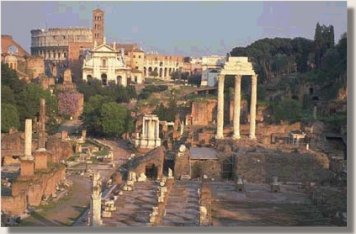 The Ancient
centre - The Capitol, the southern summit of the Capitoline Hill , was the
symbolic centre of the Roman world and home to the city’s three most
important temples.
These were dedicated to the god Jupiter Optimus Maximus, protector of
Rome, Minerva, goddess of wisdom and war, and Juno Moneta, a guardian
goddess. Below the Capitoline lies the Forum, once the
focus of political, social, legal and commercial life; the Imperial Fora,
built when Rome’s population grew; and the Colosseum, the centre of
entertainment. In the early Republic, the Forum was a chaotic place, with
food stalls and brothels as well as temples and the Senate House. By the 2nd
century BC it was decided that Rome required a more salubrious centre, and
the food stores were replaced by business centres and law courts. The
Forum remained the ceremonial centre of the city under the Empire, with
emperors renovating old buildings and erecting new temples and monuments. The Ancient
centre - The Capitol, the southern summit of the Capitoline Hill , was the
symbolic centre of the Roman world and home to the city’s three most
important temples.
These were dedicated to the god Jupiter Optimus Maximus, protector of
Rome, Minerva, goddess of wisdom and war, and Juno Moneta, a guardian
goddess. Below the Capitoline lies the Forum, once the
focus of political, social, legal and commercial life; the Imperial Fora,
built when Rome’s population grew; and the Colosseum, the centre of
entertainment. In the early Republic, the Forum was a chaotic place, with
food stalls and brothels as well as temples and the Senate House. By the 2nd
century BC it was decided that Rome required a more salubrious centre, and
the food stores were replaced by business centres and law courts. The
Forum remained the ceremonial centre of the city under the Empire, with
emperors renovating old buildings and erecting new temples and monuments.
Overlooking the forum is the Palatine Hill, where Romulus is said to have founded Rome in the 8th century BC, and emperors lived for 4000 years. |
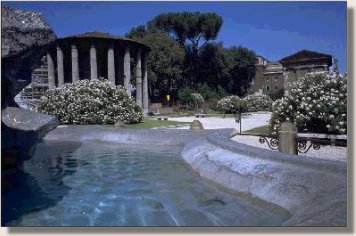 Temples of
the Forum Boarium - These wonderfully well preserved Republican
temples are at their very best at moonlight , standing in their grassy
enclave beside the Tiber sheltered by the umbrella pines. During the day
they look less romantic, stranded in a sea of traffic. They date from the
2nds century BC, and were saved from ruin by being consecrated as
Christian churches in the Middle ages by the Greek community then living
in the area. The smaller circular temple which is made of solid marble and
surrounded by 20 fluted columns, was dedicated to Hercules, though it was
long believed to be a Temple of Vesta, because of its similarity to the
one in the Forum. Temples of
the Forum Boarium - These wonderfully well preserved Republican
temples are at their very best at moonlight , standing in their grassy
enclave beside the Tiber sheltered by the umbrella pines. During the day
they look less romantic, stranded in a sea of traffic. They date from the
2nds century BC, and were saved from ruin by being consecrated as
Christian churches in the Middle ages by the Greek community then living
in the area. The smaller circular temple which is made of solid marble and
surrounded by 20 fluted columns, was dedicated to Hercules, though it was
long believed to be a Temple of Vesta, because of its similarity to the
one in the Forum. |
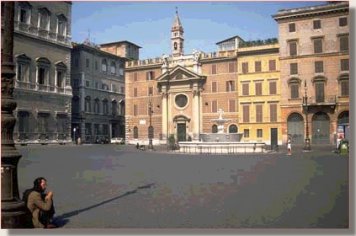 Santa
Maria in Trastevere - The façade of Santa Maria in Trastevere
built in the twelft century. In the tympanum a mosaic by P.
Cavallini. The portico has five arches and a terrace above. On
the balustrade are some seventeenth century statues by ~Carlo Fontana
added in 1702. The bell-tower is in Romanesque style. Santa
Maria in Trastevere - The façade of Santa Maria in Trastevere
built in the twelft century. In the tympanum a mosaic by P.
Cavallini. The portico has five arches and a terrace above. On
the balustrade are some seventeenth century statues by ~Carlo Fontana
added in 1702. The bell-tower is in Romanesque style. |
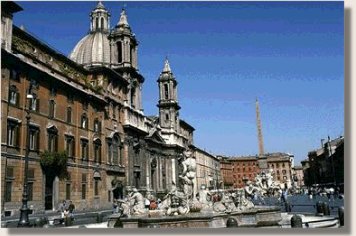 Piazza
Navona, Rome’s
most beautiful Baroque piazza follows the shape of a 1st century AD
stadium built by Domitian , which was used for athletic contests (known as
agones), chariot races and other sports. Traces of the stadium are still
visible below the magnificent church of Sant’ Agnese in Agone which
dominates the square. The Fountain, the Fontana dei Fiumi is Bernini’s
most magnificent, with statues of the four great rivers of the world (the
Nile, the Ganges, the Plate, and the Danube) sitting on rocks below the
obelisk. Until the 19th century the Piazza was flooded in
August by stopping the fountain’s outlets. The rich would splash around
in carriages, while street urchins paddled. Even today the piazza remains
a social centre of the city. Piazza
Navona, Rome’s
most beautiful Baroque piazza follows the shape of a 1st century AD
stadium built by Domitian , which was used for athletic contests (known as
agones), chariot races and other sports. Traces of the stadium are still
visible below the magnificent church of Sant’ Agnese in Agone which
dominates the square. The Fountain, the Fontana dei Fiumi is Bernini’s
most magnificent, with statues of the four great rivers of the world (the
Nile, the Ganges, the Plate, and the Danube) sitting on rocks below the
obelisk. Until the 19th century the Piazza was flooded in
August by stopping the fountain’s outlets. The rich would splash around
in carriages, while street urchins paddled. Even today the piazza remains
a social centre of the city.
In the nineteenth century, tired of Baroque and Rococco, Rome indulged in a neoclassicism which echoed the Greek architectural orders and Roman Imperial architecture. It declined to a rather cold and irritating conventionalism, however, it was in this period that several new innovations took place; for example the layout of Piazza del Popolo by Giuseppe Valadier. |
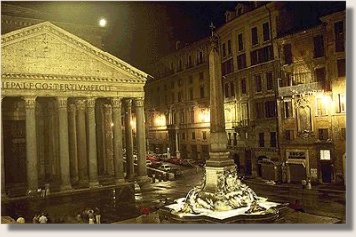 The
Pantheon - The Pantheon, the Roman ‘temple of all gods’, is the
most extraordinary and best preserved building in Rome. The first temple
on the site was a conventional rectangular affair erected by Agrippa
between 27 and 25 BC; the present structure was built and possibly
designed by Emperor Hadrian in AD 118. The
temple is fronted by a massive pedimented portico screening what appears
to be a cylinder fused to a shallow dome. Only from the inside can the
true scale and beauty be appreciated: a vast hemispherical dome equal in
radius to the height of the cylinder giving perfectly harmonious
proportions to the building. A circular opening, the oculus, lets in the
only light. The
Pantheon - The Pantheon, the Roman ‘temple of all gods’, is the
most extraordinary and best preserved building in Rome. The first temple
on the site was a conventional rectangular affair erected by Agrippa
between 27 and 25 BC; the present structure was built and possibly
designed by Emperor Hadrian in AD 118. The
temple is fronted by a massive pedimented portico screening what appears
to be a cylinder fused to a shallow dome. Only from the inside can the
true scale and beauty be appreciated: a vast hemispherical dome equal in
radius to the height of the cylinder giving perfectly harmonious
proportions to the building. A circular opening, the oculus, lets in the
only light.
|
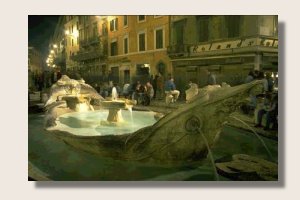 Piazza
di Spagna - Shaped
like a crooked bow tie, and surrounded
by muted shuttered facades, Piazza di Spagna
is crowded all day and
(in summer) most of the night. The most famous square in Rome, it takes
name from the Palazzo di Spagna, built in the 17th century to
house the Spanish Embassy to the Holy See. The Piazza has long been the
haunt of foreign visitors and expatriates. In the 18th and 19th
centuries the square stood at the heart of the city’s main hotel
district. Some of the travellers came in search of knowledge and
inspiration, although most were interested in collecting statues to adorn
their family homes. Piazza
di Spagna - Shaped
like a crooked bow tie, and surrounded
by muted shuttered facades, Piazza di Spagna
is crowded all day and
(in summer) most of the night. The most famous square in Rome, it takes
name from the Palazzo di Spagna, built in the 17th century to
house the Spanish Embassy to the Holy See. The Piazza has long been the
haunt of foreign visitors and expatriates. In the 18th and 19th
centuries the square stood at the heart of the city’s main hotel
district. Some of the travellers came in search of knowledge and
inspiration, although most were interested in collecting statues to adorn
their family homes.
|
|
The Spanish Steps
|
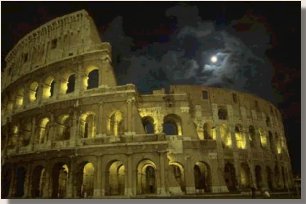 The
Colosseum is the most famous and well-known monument of Roman
antiquity. The construction of this enormous Flavian amphitheatre
was begun in 72 A.D. by the Emperors of the Flavian family and completed
under Titus in 80 A.D. It was destined to be used for gladiatorial
contests and wild beast hunts. The origin of its name is not known
precisely. Some believe it was given this name because of its
gigantic proportions; others say it refers to a colossal statue of Nero
which once stood near it. The
Colosseum is the most famous and well-known monument of Roman
antiquity. The construction of this enormous Flavian amphitheatre
was begun in 72 A.D. by the Emperors of the Flavian family and completed
under Titus in 80 A.D. It was destined to be used for gladiatorial
contests and wild beast hunts. The origin of its name is not known
precisely. Some believe it was given this name because of its
gigantic proportions; others say it refers to a colossal statue of Nero
which once stood near it. |
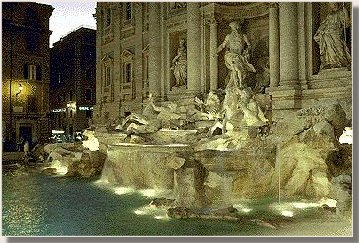 Fontana
di Trevi -
This is the masterpiece of the Roman architect Nicolò Salvi who was
commissioned by the Florentine Pope Clement XII to systematize the already
existing spring called Virgin Water. This name comes to us from an
ancient tradition which tells about a young girl who showed the spring to
some thirsty Roman soldiers. The fountain was finished in 1762, and
was called Trevi because it was constructed at a point where three roads
join together. Italians and foreigners, following the local
tradition, throw a coin into the fountain which has the virtue of ensuring
their return to Rome. Fontana
di Trevi -
This is the masterpiece of the Roman architect Nicolò Salvi who was
commissioned by the Florentine Pope Clement XII to systematize the already
existing spring called Virgin Water. This name comes to us from an
ancient tradition which tells about a young girl who showed the spring to
some thirsty Roman soldiers. The fountain was finished in 1762, and
was called Trevi because it was constructed at a point where three roads
join together. Italians and foreigners, following the local
tradition, throw a coin into the fountain which has the virtue of ensuring
their return to Rome. |
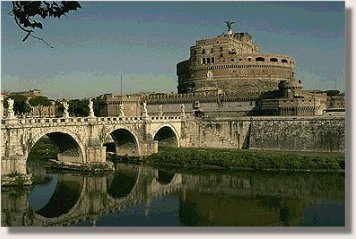 Castel
Sant' Angelo - It is one of othe most historically significant
monuments in Rome. Originally, it did not have the aspect of a
fortress, but of a mausoleum which the Emperor Hadrian planned as a
sepulcre for himself and his successors. The mausoleum, which
consisted of a large square base to support a cylindrical construction,
was begun in 135 A.D. and completed under the Emperor Antonius Pius in 139
A.D. Castel
Sant' Angelo - It is one of othe most historically significant
monuments in Rome. Originally, it did not have the aspect of a
fortress, but of a mausoleum which the Emperor Hadrian planned as a
sepulcre for himself and his successors. The mausoleum, which
consisted of a large square base to support a cylindrical construction,
was begun in 135 A.D. and completed under the Emperor Antonius Pius in 139
A.D. |
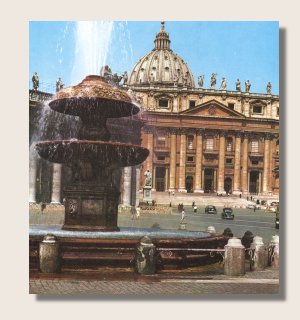 The
Basilica of St Peter - The present basilica replaced an earlier
one founded by Constantine the Great between 324 and 349. Its
foundation stone was blessed by Pope Julius II on April 18, 1506. There
were several architects involved in the work but those who was
really active in its construction were the Florentine Antonio da Sangallo
the Younger, followed by Michelangelo Buonarroti, Domenico Fontana,
Giacomo della Porta and Carlo Maderno. The basilica was consecrated
by the Florentine Pope Urban VIII on November 18, 1626. It covers a
surface of more than a hectare and a half, is 211.50 meter long including
the portico and the thickness of the walls and is 141.50 meters high. The
Basilica of St Peter - The present basilica replaced an earlier
one founded by Constantine the Great between 324 and 349. Its
foundation stone was blessed by Pope Julius II on April 18, 1506. There
were several architects involved in the work but those who was
really active in its construction were the Florentine Antonio da Sangallo
the Younger, followed by Michelangelo Buonarroti, Domenico Fontana,
Giacomo della Porta and Carlo Maderno. The basilica was consecrated
by the Florentine Pope Urban VIII on November 18, 1626. It covers a
surface of more than a hectare and a half, is 211.50 meter long including
the portico and the thickness of the walls and is 141.50 meters high. |
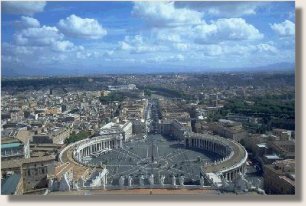 St Peter's
Square - Neopolitan Gian Lorenzo Bernini created a true masterpiece
with the two immense semicircles that relate so well with the trapezoidal
space in front of the façade of the basilica. The colonnade of
Bernini was built between 1656 and 1667. It is composed of 284
imposing columns in the Doric order and 88 pilasters. The columns
are arranged in four rows forming three covered ambulatories which
altogether measure 17 meters in width. The colonade is 19 meters
high; it encloses an area of 148 meters wide and 198 meters long. St Peter's
Square - Neopolitan Gian Lorenzo Bernini created a true masterpiece
with the two immense semicircles that relate so well with the trapezoidal
space in front of the façade of the basilica. The colonnade of
Bernini was built between 1656 and 1667. It is composed of 284
imposing columns in the Doric order and 88 pilasters. The columns
are arranged in four rows forming three covered ambulatories which
altogether measure 17 meters in width. The colonade is 19 meters
high; it encloses an area of 148 meters wide and 198 meters long. |
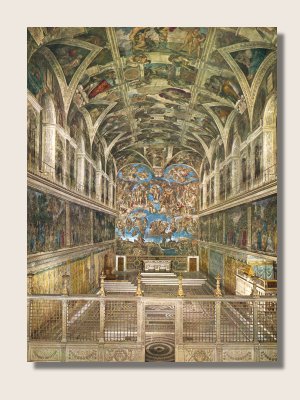 The Sistine Chapel
-
Between 1475 and 1483, Pope Sixtus IV employed the Florentine architect
Giovanino de' Dolcio to construct the ceiling. At that time it was
to serve two purposes, liturgical and defensive. The interior is
40.23 meters long, 13.41 meters wide, and 20.73 meters high. The
walls are decorated with beautiful frescoes by famous Tuscan and Umbrian
masters. But the greatest attraction of the Sistine Chapel is the marvelous
picture cycle by Michelangelo which begins with the
decoration of the enormous vault (almost 520 square meters). It
narrates different episodes of the Creation of the Universe, of Man,
Original Sin, the Flood, the Rebirth of Man and it ends with the
masterpiece frescoed on the walls of the altar (200 square meters of
surface) narrating the theme "Universal Judgment". The Sistine Chapel
-
Between 1475 and 1483, Pope Sixtus IV employed the Florentine architect
Giovanino de' Dolcio to construct the ceiling. At that time it was
to serve two purposes, liturgical and defensive. The interior is
40.23 meters long, 13.41 meters wide, and 20.73 meters high. The
walls are decorated with beautiful frescoes by famous Tuscan and Umbrian
masters. But the greatest attraction of the Sistine Chapel is the marvelous
picture cycle by Michelangelo which begins with the
decoration of the enormous vault (almost 520 square meters). It
narrates different episodes of the Creation of the Universe, of Man,
Original Sin, the Flood, the Rebirth of Man and it ends with the
masterpiece frescoed on the walls of the altar (200 square meters of
surface) narrating the theme "Universal Judgment". |
|
The Creation of Man |
The Creation of Woman |
Home Hotels Crescenza Map Transport Wishes List Notice Board
